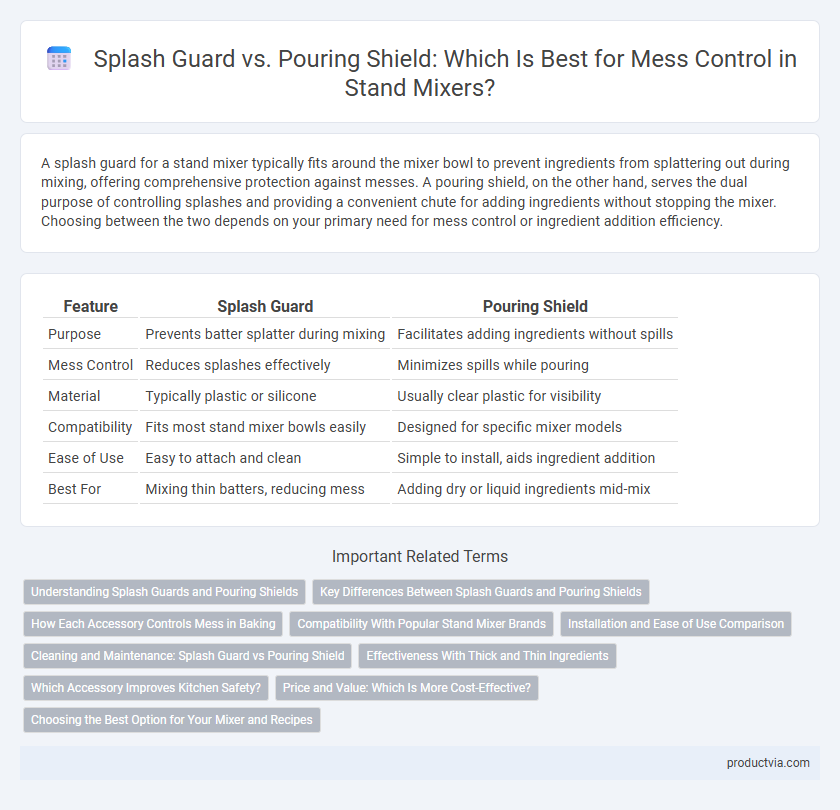A splash guard for a stand mixer typically fits around the mixer bowl to prevent ingredients from splattering out during mixing, offering comprehensive protection against messes. A pouring shield, on the other hand, serves the dual purpose of controlling splashes and providing a convenient chute for adding ingredients without stopping the mixer. Choosing between the two depends on your primary need for mess control or ingredient addition efficiency.
Table of Comparison
| Feature | Splash Guard | Pouring Shield |
|---|---|---|
| Purpose | Prevents batter splatter during mixing | Facilitates adding ingredients without spills |
| Mess Control | Reduces splashes effectively | Minimizes spills while pouring |
| Material | Typically plastic or silicone | Usually clear plastic for visibility |
| Compatibility | Fits most stand mixer bowls easily | Designed for specific mixer models |
| Ease of Use | Easy to attach and clean | Simple to install, aids ingredient addition |
| Best For | Mixing thin batters, reducing mess | Adding dry or liquid ingredients mid-mix |
Understanding Splash Guards and Pouring Shields
Splash guards and pouring shields are essential attachments for stand mixers designed to minimize mess during mixing. Splash guards fit snugly over the mixing bowl to prevent ingredients from splattering out, while pouring shields feature a chute that allows for easy ingredient addition without stopping the mixer. Both accessories enhance cleanliness and efficiency in the kitchen by controlling spills and splashes effectively.
Key Differences Between Splash Guards and Pouring Shields
Splash guards are typically designed to prevent ingredients from splattering out of the bowl during high-speed mixing, offering broader coverage around the mixing bowl's rim. Pouring shields serve a dual purpose by allowing users to add ingredients while mixing and minimizing mess through a narrower opening or spout. The key difference lies in their function and design: splash guards focus on containment, while pouring shields prioritize ingredient addition with controlled mess reduction.
How Each Accessory Controls Mess in Baking
A splash guard prevents batter and ingredients from splattering out of the bowl by providing a physical barrier around the mixing area, minimizing mess during high-speed mixing. A pouring shield, designed with a chute or spout, controls mess by allowing precise ingredient addition without stopping the mixer, reducing spills and stray splashes. Both accessories enhance cleanliness, but the splash guard excels at containment, while the pouring shield optimizes ingredient incorporation.
Compatibility With Popular Stand Mixer Brands
Splash guards and pouring shields both enhance mess control during mixing but differ in compatibility with popular stand mixer brands like KitchenAid, Cuisinart, and Kenwood. Splash guards typically fit specific bowl sizes and mixer models, offering a tight seal to prevent ingredient splatter, while pouring shields often provide a universal design that accommodates various bowl shapes and sizes. Choosing between the two depends on your stand mixer's brand and model to ensure optimal fit and efficient mess reduction.
Installation and Ease of Use Comparison
Splash guards typically install by snapping directly onto the bowl rim for quick setup, providing basic mess control by reducing splatter during mixing. Pouring shields often feature a more secure attachment with integrated pour spouts, allowing easier ingredient addition without removing the shield, enhancing convenience during use. The pouring shield's ergonomic design generally offers superior ease of use by minimizing interruptions and mess, making it a preferred choice for frequent ingredient incorporation.
Cleaning and Maintenance: Splash Guard vs Pouring Shield
A splash guard on a stand mixer is typically simpler to clean due to its smaller size and fewer crevices, making it easier to rinse or wipe down after mixing. In contrast, a pouring shield often features a larger opening and multiple parts, which can trap ingredients and require more thorough scrubbing to maintain proper hygiene. Choosing between the two depends on prioritizing ease of cleaning versus functionality in preventing splatters during high-speed mixing.
Effectiveness With Thick and Thin Ingredients
Splash guards are highly effective for thick ingredients, preventing heavy splatter during vigorous mixing by securely fitting around the bowl while allowing easy access to the paddle or whisk. Pouring shields excel with thin and liquid mixtures by providing a wider spout that minimizes spills when adding ingredients, ensuring more controlled pouring without interrupting the mixing process. Selecting the right attachment depends on recipe consistency, where splash guards contain dense doughs and pouring shields manage watery batters, optimizing mess control in stand mixers.
Which Accessory Improves Kitchen Safety?
A splash guard enhances kitchen safety by preventing hot ingredients from splattering, reducing burn risks and maintaining a clean workspace. Pouring shields primarily minimize spills while adding ingredients but offer less protection against hot splashes or flying debris. For optimal mess control and enhanced safety, a splash guard is the superior accessory on stand mixers.
Price and Value: Which Is More Cost-Effective?
Splash guards typically cost less than pouring shields, making them a budget-friendly option for mess control during mixing. Pouring shields, although pricier, offer enhanced coverage by preventing spills and splatters more effectively, adding value for frequent bakers. Evaluating price against durability and cleaning convenience helps determine which accessory delivers better cost-effectiveness for your stand mixer needs.
Choosing the Best Option for Your Mixer and Recipes
Splash guards and pouring shields both prevent messes while mixing, but choosing between them depends on your mixer model and recipe needs. Splash guards are ideal for high-speed mixing with liquid or powder ingredients, minimizing splatter. Pouring shields offer a controlled, wide opening for gradually adding ingredients without stopping the mixer, perfect for batters and doughs requiring incremental additions.
Splash guard vs Pouring shield for mess control Infographic

 productvia.com
productvia.com